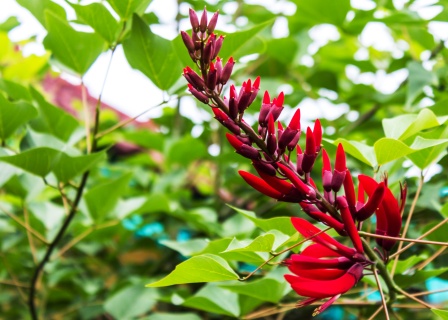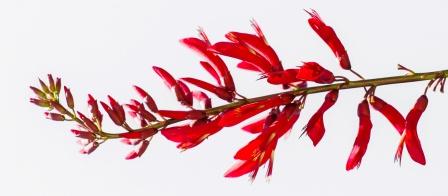Paribhadra – Erythrina indica Uses, Research, Side Effects
Paribhadra, Erythrina variegata or indica is also called Indian coral tree. It is used for treating intestinal worms, anorexia, cholesterol imbalance etc.
Botanical name- Erythrina indica Lamk (Erythrina Variegata Linn. Var Orientalis(Linn) Merrill.
Family- Fabaceae (Pea family), Papilionaceae (Shimbi Kula)

The plants can be found in almost all states of India.
Even though red colored flower possessing trees are found abundantly, white colored flower bearing trees are rich with medicinal properties and they are considered to be more soothing in nature.
Table of Contents
Home remedies
Few important simple remedies and their health benefits are mentioned here below-
Ear ache
Water distillate of the bark for earache:
Classical literature emphasizes its use in Ear related various disorders and Acharya PV Sharma refers to it as a potent Karnya drug (tonic for the ears).
Fresh or dry bark of the plant is taken and soaked in water overnight. Next day morning it is distilled with the help of a pressure cooker. The distillate is preserved in glass bottles. This distillate is used as ear drops – 3- 4 drops 2 times a day for the treatment of earache.
Menstrual pain, irregular menstruation
Decoction of the stem bark for menstrual pain and irregular menstruation:
The stem bark decoction is administered during the period of menstruation in cases of severe menstrual pain. Any antispasmodic tablet like Dhanvantari vati, Chitrakadi vati etc can also be used meanwhile.
General method of preparation of decoction (kashaya) – 1 tablespoon of powder is added with 2 cups of water, boiled and reduced to 1 cup, filtered.
In irregular cycles the decoction is advised to take daily once from 10th day of menstruation to the 20th day. This is repeated for three consecutive periods.
Furunculosis
Flower –hot infusion wash for furunculosis:
Hot infusion of the flowers is used to wash the external pinna of the ears in the cases of furunculosis. In folliculitis also this is used to wash the legs.
Dysuria
Leaf cold infusion or fresh juice for dysuria:
The fresh juice or cold infusion of the leaves is taken internally once or twice a day. It is effective in burning urination.
The leaves are the favorite food for the goats and sheeps.
Before the modern devices related to the incubators, in village sides the Dais used to apply the egg white all over the body of the preterm baby and they used to wrap the body with the leaves of Paribhadra. If some studies are carried out, fruitful things can surface out of ancient wisdom.
Nature has given us everything…. The question is do we help/give back anything to this God’s greatest gift nature. It is important to safeguard each plant’s natural resources. Also unnecessary plucking of flowers and leaves, cutting the twigs and branches, peeling or separating the stem barks etc should be avoided and these are also great contributions to preserve and protect mother nature.
Vernacular names
Names in different languages:
English name- Indian Koral tree, Indian Coral Tree, Tiger’s Claw, Lenten tree
Hindi name- Pharhada, Farhad, Pangra, महामेद mahamed, मन्दार mandar, पांगरा pangra, पारिभद्र paribhadra, पारिजात parijat
Kannada name – Halivana, Haaluvana, ಹೊಮ್ಗಾರ homgaara
Malayalam name – Mulmurukku, മുള്മുരിക്ക് mulmurikk, മുരിക്ക് murikk, പെണ്മുരിക്ക് penmurikk
Telugu name- Badida Chettu, Badachipa Chettu, బాడినెచెట్టు badidepuchettu, ముచ్చెకర్ర muchchekarra
Bengali name – Palte Madar, ডেও deo, ডেউয়া deuya, মাদার maadaara, মন্দার mandaara
Marathi name – Pangara, पांगारा pangara
Gujarati name – Pararu, પાનરવો paanarvo
Assamese name – মদাৰ madaar
Nepalese name – मन्दार् mandar, फलेदो phaledo •
Tamil name – சிவப்புமொச்சை civappu-moccai, கிஞ்சுகம் kincukam, முள்ளுமுருக்கு mullu-murukku, நவிர் navir, பலாசம் palacam, பாரிசாதம் paricatam (Source)

Properties, part used, dosage
Erythrina indica medicinal Properties:
Guna (qualities) – Laghu – light to digest
Rasa (taste) – Katu (pungent), Tikta – bitter
Vipaka- Katu – Undergoes pungent taste conversion after digestion
Veerya – Ushna – Hot potency
Effect on Tridosha – Balances Kapha and Vata Dosha.
Part used- Stem bark, Leaf, flower
Dosage-
Decoction 50-100 ml; fresh juice 10-20 ml
The plants undergo a pungent kind of bio transformation and are hot in potency. Mainly these are Vata-kaphahara in nature. Whereas flowers are Pitta pacifying in nature. White flower bearing plants are believed to be cold in potency.
Uses, indications
Erythrina indica medical uses:
Bark:
Deepana – improves digestion strength
Medahara – reduces cholesterol, useful in obesity treatment
Indicated in –
Shotha – Swelling, inflammation
Krumi – worm infestation
Arochaka – anorexia
Bark is antibilious (useful in liver disorders), febrifuge (useful in fever), astringent, expectorant (expels out sputum).
Bark is used in liver ailments, fever and rheumatism.
Flower and leaves:
Balance Pitta.
Indicated in
Karnavyadhi – ear disorders, earache. Its leaf juice is used as an ear drop to relieve ear pain.
Leaf – mild purgative, diuretic, antiseptic, anti-inflammatory.
Reproductive system:
In women, it is used in cases of amenorrhoea and delayed periods. It is a very good uterine tonic.
In Karnataka, in folklore practice, bark & leaf in the form of paste is administered orally and externally, to improve lactation. So the name Haluvana (Halu means milk in Kannada).
In men, it is used as an aphrodisiac.
It is used as an antidote in Kupeelu (Strychnos nux vomica) Poisoning. (PV Sharma).
Interaction with medicines, supplements
Can this be used while taking Homeopathic medicine?
Yes. This product does not react with homeopathic medicine.
Can this medicine be continued while taking supplements like multivitamin tablets, Omega 3 fatty acids etc?
Yes. Generally, this product goes well with most dietary supplements. However, if you are taking more than one product per day, please consult your doctor for an opinion.
With western
medicines
Seek your
doctor’s advice if you are taking this product along with other western
(allopathic / modern) medicines. Some Ayurvedic herbs can interact with modern
medicine.
If both Ayurvedic and allopathic medicines are advised together, then it is
best to take Allopathic medicine first, wait for 30 minutes and then take the
Ayurvedic medicine.
Ayurvedic medicines
Ayurvedic medicines with Paribhadra as ingredient:
Click on the medicine name to know more about it.
Sri Gopal Taila – oil used in various neuro-muscular conditions, to improve brain and memory power etc. . It is also used to treat ED problems . It is a versatile herbal oil with various health benefits.
Murivenna oil – It is a renowned oil for non healing wounds, fractures and sprains.
Abhay Lavana – used in the treatment of liver and spleen disorders. It is in powder form.
Maharajaprasarini oil -used for internal and external applications. It is used in neurological problems.
Narayanataila and Mahanarayan taila – used in the treatment of many neuro- muscular and skeletal-muscular conditions, such as arthritis, neuralgia etc.
Research
Anti microbial activity of stem extracts – Antimicrobial activity of methanolic, chloroform, hexane and aqueous stem extracts of Erythrina variegata were analysed against bacterial pathogens such as Salmonella typhi, Pseudomonas putida, Pseudomonas aeruginosa, Escherichia coli, etc and fungal pathogens viz. Aspergillus niger, Aspergillus fumigatus, Candida sp. etc. Among all the strains, few strains like Serratia marcescens , E.coli, Pseudomonas putida, Bacillus circulans were found to be more susceptible strains and among all the solvent extracts methanol showed promising antimicrobial activity. The results obtained in this study suggested that the stem extract of Erythrina variegate L. have high potential for use in the treatment of diseases caused by these test organisms.
Sanskrit synonyms
Sanskrit Synonyms of Paribhadra:
Prabhadra, Paribhadra – Auspicious
Nimbadruma, Mandaraka, Parijata,
Raktapushpa, Rakta Kesara – has red flower
Bahupushpa – Numerous flowers are seen on the tree
Kantaki Palasha, Kantaki Kimshuka – Resembles Palasha tree – Butea monosperma, but has thorns (Kantaka).
Krumighna – useful against intestinal worm infestations
Classical categorization
Classical categorisation of Erythrina variegata
Kaiyadeva Nighantu – Oshadhi Varga, Nishiddha Danta kashta – twigs of which should not be used as a toothbrush.
Bhavaprakasha – Guduchyadi Varga
Raja Nighantu – Shalmalyadi Varga
Chemical constituents
Erythrina indica chemical Constituents:
Seeds- Erthyraline, Erysovine,
Bark- Erythrinins A.B,C; erysotine, erythratidine, epierythratidine etc; Bark has 0.05 % of alkaloids that are neuromuscular blocking, smooth muscle relaxant and CNS depressant.
Flowers-Erthrartine.
Leaves- Ertybidine. Leaves contain many alkaloids with anti-inflammatory activity.
Erysotrine, Erysodine, Erysovine, Erysonine, Hypaphorine, 8 spiroamine alkaloids, flavones, Osajin, Erythrinins A,B,C, sterols in bark
Trunk contains alkaloids which are neuromuscular blocker, spasmolytic, CNS depressant, anti-convulsant.
Plant contains many tetracyclik alkaloids, mainly hexabarbital, which has shown muscle relaxant activity.
Utpathi sthana
Distributed in all over India, especially forest areas
Sthanika Karma (Systemic Action)
External – External application of its paste indicated in edema, wounds, and ear disorders. Leaf juice is used in ear diseases. Paste can be applied in swelling around wounds, joint inflammation, conjunctivitis etc.
Nervous System – Induce sleep, pacify vata dosha, indicated in convulsions, sleep disorders etc.
Digestive System – Being bitter and hot, it stimulates taste buds, carminative, digestive, facilitates movement of doshas in proper direction, reduces cramp, Anti microbial, and stimulates bile production. Indicated in loss of appetite, abdominal cramp, constipation and in helminthiasis.
Circulatory System – Being Bitter in taste it act as a blood purifier, indicated in Syphilis
Respiratory System – Help for the elimination of vitiated kapha dosha, Indicated in Cough
Excretory System – Induce urine production, indicated in dysuria
Reproductive system – Induce menstrual bleeding, so indicated in dysmenorrhea, loss of libido etc.
Skin – Indicated skin diseases
Satmikarana – medonashaka (Helps in obesity related disorders) indicated in Strychnos poisoning
Tapakrama – it has bitter taste, helps to reduce fever











One comment
Satwant Singh
Dr. Can one use Abhay Lavana for treatment of Fatty Lever- Grade 1?
If so what is the quantity to be taken & How long?
Is it availalble at your end? If so what is the price for delivery in Mumbai.